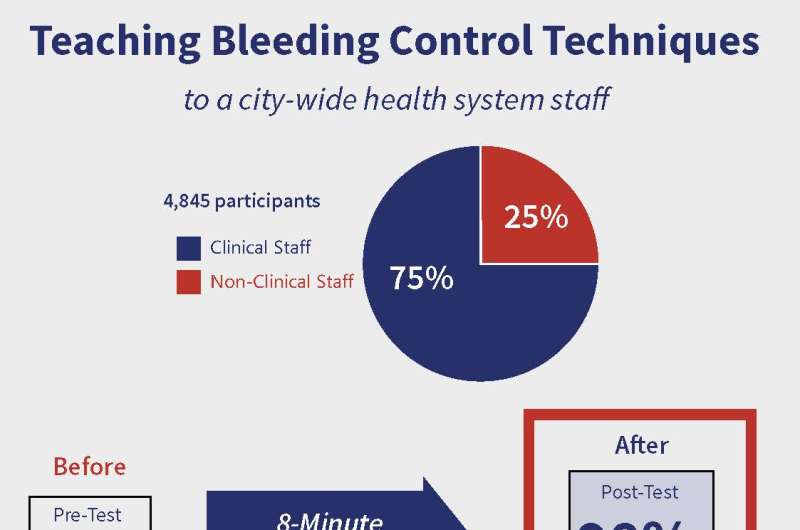Brief module effective in teaching hemorrhage control basics to staff in a large workplace

A medical team has developed a way to effectively provide a large group of people with basic knowledge and skills to locate and use bleeding control equipment to stop life-threatening bleeding in severely injured people. This effort comes amid the national push to train the U.S. civilian population in hemorrhage control techniques. The research team from UnityPoint Health, Des Moines, Iowa, reported their results in an "article in press" appearing on the Journal of the American College of Surgeons website in advance of print publication.
In response to active shooter and mass casualty incidents such as the one at Sandy Hook Elementary in 2012, the Hartford Consensus and the White House's Stop the Bleed campaign have sought to train civilians in hemorrhage control techniques so that bystanders can serve as immediate responders in the case of uncontrolled hemorrhage. One result of these efforts is the Bleeding Control (B-Con) course, a joint product of the American College of Surgeons Committee on Trauma and the National Association of Emergency Medical Technicians' Prehospital Trauma Life Support. The B-Con course consists of a two-and-a-half hour educational course with didactic lectures and hands-on training.
In line with the efforts of the B-Con course, the researchers at UnityPoint Health wanted to see if they could take the important information from the course and make it available to a wider population that may not otherwise have the time or resources to undergo a full B-Con course.
"We are trying to take the principles from B-Con and get that knowledge in a package that is efficient for a larger scale," said Richard A. Sidwell, MD, FACS, lead author and a trauma surgeon at UnityPoint Health.
In May 2016, the research team launched an educational module to train 5,800 full-time employees of a city-wide health system in hemorrhage control techniques. The eight-minute module was developed to inform staff members where bleeding control bags were located and demonstrated how to apply direct pressure to a wound and how to apply a tourniquet.
Participants were administered a pre-test to assess their knowledge of hemorrhage control techniques. The same test was then administered after the module to gauge the effectiveness of the training. Dr. Sidwell and his fellow researchers noted that although there is emerging attention on efforts to educate the public in hemorrhage control techniques, this effort is the first attempt to assess whether an electronic module can be effective in educating a workforce.Fifty-seven percent of the questions on the pre-test were answered correctly by the 4,845 participants who completed the module and answered all of the questions, and 98 percent of the questions were answered correctly on the post-test."Results suggest that we were able to successfully and efficiently provide basic knowledge of hemorrhage control to more than 4,800 hospital employees," the researchers wrote in the article. "Notably, the module was equally effective for clinical and nonclinical staff."
Of the 4,845 employees who responded, 55 percent had direct patient care responsibilities, 20 percent provided ancillary care service, and 25 percent had nonclinical roles. Further, 30 percent of respondents had no first aid training and 17 percent held a high school degree or lower. Dr. Sidwell said the people who participated in the module found it interesting and engaging, and the overall feedback in the hospital has been very positive.
Because of their success at UnityPoint Health in this regard, Dr. Sidwell said that they believe this sort of module can be easily adapted to large groups in other settings. "It is imperative that the general public is knowledgeable in the basic tenets of hemorrhage control. These results demonstrate that a brief electronic educational module could effectively educate employees in a large workplace on the basics of hemorrhage control," according to researchers.
Dr. Sidwell and his team acknowledged certain limitations of the study, noting that it is unclear how much of the information is retained by respondents over time, and that the module does not include hands-on training, meaning they were not able to verify the skills of respondents in hemorrhage control techniques. To address this issue, Dr. Sidwell said that the next step they are working on is to reinforce knowledge, assess retention, and add in a skills component beyond the computer module.
More information: Effective Hospital-Wide Education in Hemorrhage Control. Journal of the American College of Surgeons, 2017.
















